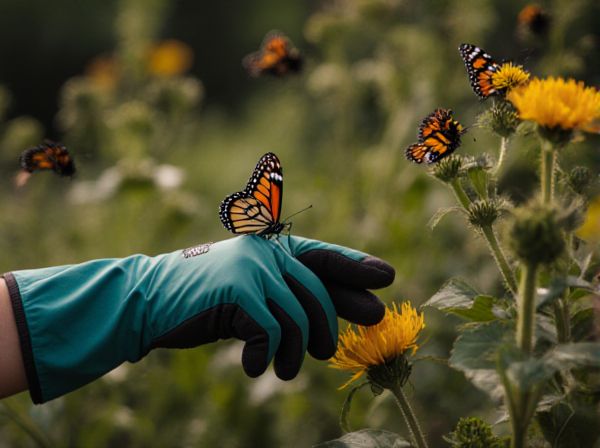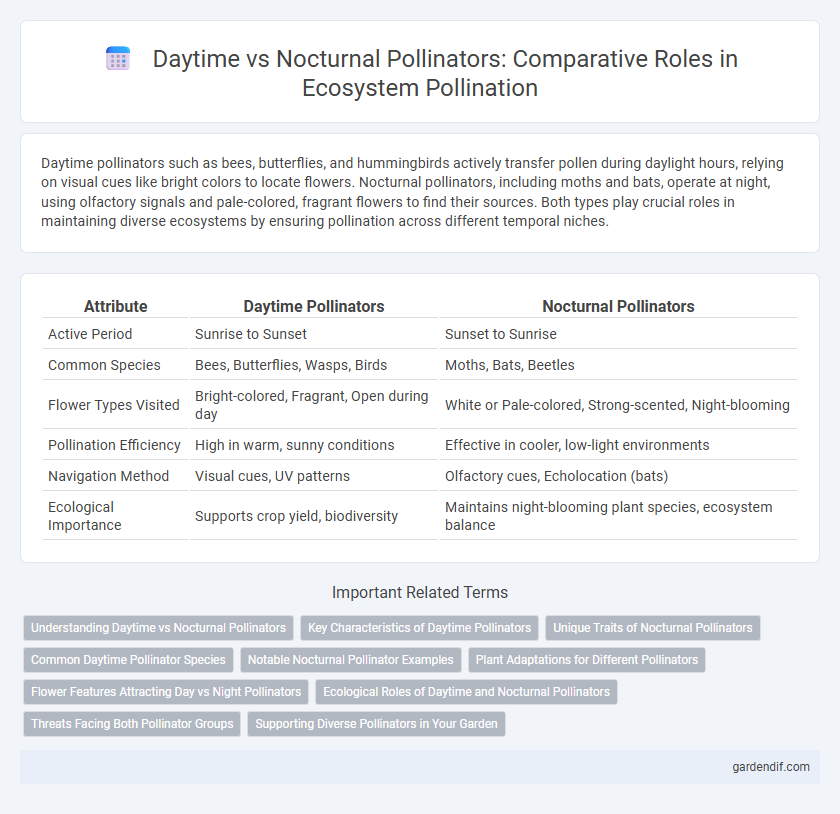
Daytime Pollinators vs Nocturnal Pollinators Illustration
Daytime pollinators such as bees, butterflies, and hummingbirds actively transfer pollen during daylight hours, relying on visual cues like bright colors to locate flowers. Nocturnal pollinators, including moths and bats, operate at night, using olfactory signals and pale-colored, fragrant flowers to find their sources. Both types play crucial roles in maintaining diverse ecosystems by ensuring pollination across different temporal niches.
Table of Comparison
| Attribute | Daytime Pollinators | Nocturnal Pollinators |
|---|---|---|
| Active Period | Sunrise to Sunset | Sunset to Sunrise |
| Common Species | Bees, Butterflies, Wasps, Birds | Moths, Bats, Beetles |
| Flower Types Visited | Bright-colored, Fragrant, Open during day | White or Pale-colored, Strong-scented, Night-blooming |
| Pollination Efficiency | High in warm, sunny conditions | Effective in cooler, low-light environments |
| Navigation Method | Visual cues, UV patterns | Olfactory cues, Echolocation (bats) |
| Ecological Importance | Supports crop yield, biodiversity | Maintains night-blooming plant species, ecosystem balance |
Understanding Daytime vs Nocturnal Pollinators
Daytime pollinators, such as bees and butterflies, rely heavily on visual cues and bright floral colors to locate nectar during daylight hours, enhancing plant reproduction through efficient pollen transfer. Nocturnal pollinators, including moths and bats, depend more on olfactory signals and pale or white flowers that reflect moonlight to navigate and feed in low-light conditions. Understanding these distinct sensory adaptations highlights the complementary roles both pollinator groups play in maintaining biodiversity and ecosystem stability.
Key Characteristics of Daytime Pollinators
Daytime pollinators, such as bees, butterflies, and hoverflies, are characterized by their reliance on visual cues like bright flower colors and patterns to locate nectar. These pollinators have acute color vision, allowing them to distinguish ultraviolet patterns on petals that are invisible to humans. Their activity during daylight hours aligns with flowers that open and release scents in the morning, optimizing pollination efficiency through synchronized behavior.
Unique Traits of Nocturnal Pollinators
Nocturnal pollinators, such as moths, bats, and certain beetles, possess unique traits adapted to nighttime activity, including enhanced sensory systems like echolocation and heightened olfactory receptors that help locate flowers in low light. Unlike daytime pollinators, they often rely on pale or white, highly fragrant flowers that open at night to attract them, facilitating effective pollination in darkness. Their role is crucial for the reproduction of night-blooming plant species, contributing significantly to ecosystem biodiversity and stability.
Common Daytime Pollinator Species
Common daytime pollinator species include honeybees (Apis mellifera), bumblebees (Bombus spp.), butterflies (Lepidoptera), and hoverflies (Syrphidae), all of which actively forage during daylight hours. These species are crucial for pollination of many flowering plants, contributing significantly to ecosystem stability and agricultural productivity. Their visual navigation and flower color preference enhance pollination efficiency compared to nocturnal pollinators like moths and bats.
Notable Nocturnal Pollinator Examples
Notable nocturnal pollinators include moths, bats, and certain beetles, which play a crucial role in pollinating night-blooming plants such as yucca and agave. These pollinators rely on enhanced sensory adaptations like echolocation in bats and strong olfactory cues in moths to locate flowers in low-light conditions. Their activity complements daytime pollinators by ensuring continuous pollination and contributing to the biodiversity of ecosystems.
Plant Adaptations for Different Pollinators
Plants have evolved specific adaptations to attract daytime pollinators such as bees and butterflies, including brightly colored petals and sweet scents that are most potent during daylight hours. In contrast, plants pollinated by nocturnal pollinators like moths and bats often emit strong, musky fragrances and display pale or white flowers that are highly visible in low light. These specialized traits ensure effective pollination by matching the sensory preferences and activity periods of their respective pollinator groups.
Flower Features Attracting Day vs Night Pollinators
Daytime pollinators such as bees and butterflies are attracted to brightly colored flowers with strong ultraviolet patterns and sweet fragrances that are most potent during daylight. Nocturnal pollinators like moths and bats prefer pale or white flowers with large, open shapes and intense, musky scents that enhance visibility and scent detection in low light conditions. Flower adaptations like nectar production timing and scent emission align closely with the activity periods of their respective pollinators, optimizing pollination efficiency.
Ecological Roles of Daytime and Nocturnal Pollinators
Daytime pollinators, such as bees and butterflies, play a crucial role in the pollination of flowering plants that bloom in sunlight, facilitating the reproduction of a vast majority of angiosperms and supporting ecosystems reliant on these plants. Nocturnal pollinators, including moths and bats, contribute significantly to the pollination of night-blooming species, maintaining genetic diversity and aiding in the survival of plants adapted to darkness. Together, these pollinator groups ensure continuous plant reproduction cycles, promote biodiversity, and sustain food webs in diverse habitats.
Threats Facing Both Pollinator Groups
Daytime pollinators such as bees and butterflies face threats including habitat loss, pesticide exposure, and climate change disrupting floral resources. Nocturnal pollinators like moths and bats encounter challenges from light pollution, habitat fragmentation, and declining food sources caused by environmental degradation. Both groups are essential for ecosystem health and biodiversity, but their differing activity periods expose them to unique but overlapping risks that threaten pollination services globally.
Supporting Diverse Pollinators in Your Garden
Supporting diverse pollinators in your garden involves creating habitats that cater to both daytime pollinators like bees, butterflies, and hoverflies, and nocturnal pollinators such as moths and bats. Planting a mix of native flowering plants that bloom at different times ensures a continuous nectar supply, while providing shelter like shrubs, trees, and undisturbed soil supports nesting and roosting. Incorporating water sources and avoiding pesticides further enhances the health and diversity of pollinator populations, promoting a balanced ecosystem.
Daytime Pollinators vs Nocturnal Pollinators Infographic

 gardendif.com
gardendif.com